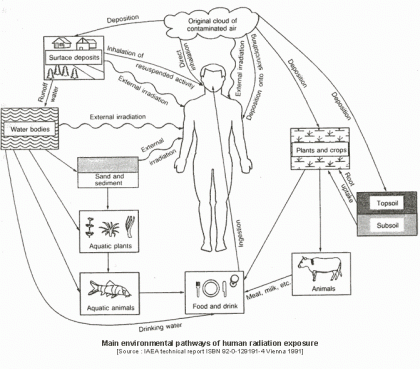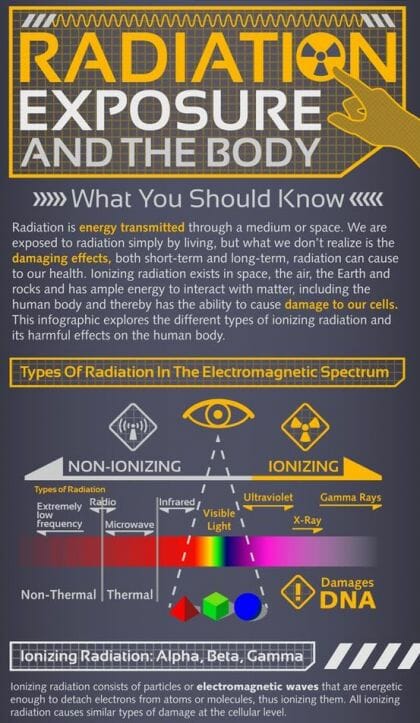SAFETY
Radiation in Chernobyl now and then
Radiation is a common way of emitting energy and it is common everywhere in the world, including within our bodies. For decades the word “radiation” has been connected or localised with a place that changed the history of mankind. Chernobyl is a symbol of the largest nuclear energy disaster in the history of mankind with some fatal consequences caused by the radiation spread from the explosion of the 4th unit of the Chernobyl Nuclear power plant. The levels of radiation in the Chernobyl power plant and the nearby area (including the city of Pripyat) ranged from 0.1 to 300 Sieverts per hour (almost billion – 1,000,000,000 times more than the usual natural background radiation measured in microSieverts – μSv). Mostly radioactive isotopes of iodine 131, caesium 137 and strontium 90 were thrown into the air. Spending even 10 minutes around the burning reactor would result in Acute Radiation Sickness (ARS) and cause hazard to life.
How did the radiation after the accident drop in Chernobyl
Weeks after the Chernobyl accident with the continuing liquidation work (the fire at the reactor core was fully extinguished two weeks after the explosion) and in addition to the fact that the most dangerous particles (e.g. Iodine 131) had a very short half-life* and turned into less dangerous or stable isotopes, the radiation level in Pripyat and around Chernobyl Power plant was slowly dropping. Building the new and safe Chernobyl confinement, the sarcophagus (completed by November 30, 1986, in the astonishing time of only 7 months) over the destroyed reactor no. 4 helped the radiation to further decrease and allowed people to conduct further liquidation work in the Chernobyl Exclusion zone. The radioactive isotopes are typically rather heavy and hence naturally go deeper into the soil; every year they decrease by around one centimetre, sinking down into the soil.
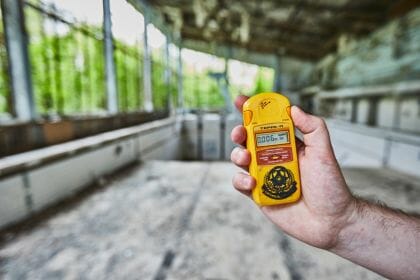
HALF LIFE? …BUT I WANT FULL LIFE!
*Half-life is the time taken for the radioactivity of a specified isotope to fall to half its original value. This means that radioactivity never really disappears, but after enough time it can become negligible. For example, after 10 half-lives the radioactivity drops by 1000 times, after 20 half-lives by 1 000 000, etc.
Where is the radiation in the Chernobyl zone today?
Nowadays, the evacuated areas in Chernobyl remain a wasteland, however – to your surprise, it is very hard to find radioactivity that exceeds the natural background radiation. Also, that is one of the reasons that the 30-kilometre Chernobyl exclusion zone has now been turned into a nature reserve. Within the 10-kilometre Chernobyl zone you can still find radioactive hotspots, i.e. spots on the ground with condensed radiation that still exceed the natural level by a hundred and even a thousand times. During your Chernobyl trip, you will be shown such places, however, you will stay neither close, nor long. Just fine for a quick radiation safety measurement that can be handy in the future for you. Even the Red Forest area (the pine forest behind the Chernobyl power plant that dried up, due to the radiation a few days after the accident) is only a drive-through visit on your Chernobyl tour.
In 2016, when the New Safe Confinement was slid over the old sarcophagus, the radiation levels around the Chernobyl power plant dropped by 3-4 times and are now 1.2 μSv (microSieverts) per hour. In the nearby city of Pripyat, the radiation level can reach 0.9 μSv/hour at some places, but typically it does not exceed the natural radiation levels of 0.3 μSv /hour. The radiation levels vary, based on, for example, the weather (lower in the winter, higher in the summer).
Is it safe to visit Chernobyl nowadays?
After all these years it is safer than ever to travel to Chernobyl. Operating Chernobyl tours since 2008 ChernobylX has developed the safest routes avoiding radioactive places during the Chernobyl tours, or the group is near to these places for only a brief amount of time. Still we manage to see all the most important and interesting places and buildings, and on some tours, even inside the Chernobyl power plant and even in the control room of reactor number #4 (available only on Chernobyl private tours.

During one day spent in the Chernobyl exclusion zone the body receives a dose of radiation comparable to the natural background radiation found all around us. To put this in perspective, this dose is typically 300 times less than a whole-body X-ray scan and is comparable to several hours spent on an aeroplane, where we are more exposed to cosmic radiation coming from the outer space. In figures, you will receive 3-5 μSv of gamma radiation in one day (see the types of radiation below), a dose of radiation that is absolutely not harmful. In comparison, most of the nuclear power plants around the world have a safety limit for their employees set at 50-100 μSv per day. Most probably you will get more radiation during your flight to Kyiv than from one day in Chernobyl.
What are the rules to follow when visiting Chernobyl?
Visitors to the Chernobyl exclusion zone should avoid radioactive dust, which might occur at some places in windy weather and get stuck in small (not dangerous) amounts on their clothes or shoes. ChernobylX suggests that all visitors wash all their clothes and shoes thoroughly as soon as they return home from their Chernobyl tour. Every adventurer travelling to Pripyat and the Chernobyl zone with ChernobylX gets a free fabric respirator. And, as the only tour company in Ukraine, we also offer you the use of Geiger Muller counters free of charge, in order to improve your comfort and safety. Despite the low risk, and there have been no more than 10 cases in 14 years when our tourists had to wash their shoes before passing the Chernobyl dosimetric control (with us you will pass it at least twice a day), we ask you to stay close to your guide and obey his or her instructions. This way, we can ensure a 100% safe Chernobyl tour for you.
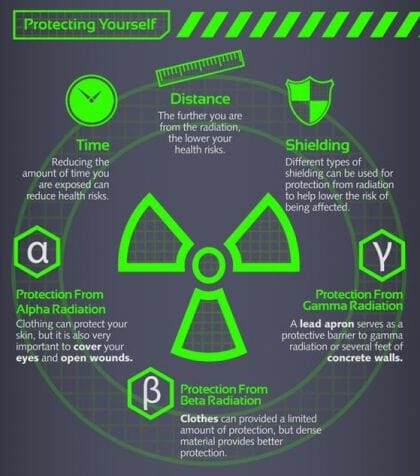
More on radiation and safety before going to Chernobyl
RADIATION 101
All the objects around us, including our bodies, are made from atoms, which are composed of protons and neutrons found in the nucleus, and the electrons orbiting them. Atoms of the same chemical element have the same number of protons but can differ in the number of neutrons. We call these different variants of the same element isotopes. For example, two of the most well-known isotopes of carbon are the so-called carbon-12 and carbon-14, where the number indicates the total number of protons and neutrons.
We can then divide all isotopes, based on whether they are stable or change in a process that we call radioactive decay, or simply just radioactivity. The speed with which some radioactive isotopes decay is characterised by the half-life, which varies from tiny fractions of a second to billions of years. If the half-life is short, the decay is fast, and we say that such an isotope is more radioactive, and vice versa.
It is important to understand that certain levels of radioactivity are very common, because every element has some radioactive isotopes and many of them can be found naturally around us. This makes all objects around us radioactive to some extent, even including our bodies that contain small amounts of radioactive carbon-14 and potassium-40, and typically around 8000 atoms of it decay every second. Our bodies are, of course, accustomed to these low levels of radioactivity, which are harmless.
Good vs. bad radiation – what radiation is dangerous to my body?
Radiation is the transportation of energy and can be divided into either ionizing or non-ionizing based on its ability to ionize atoms and molecules and disrupt the chemical bonds among them. For example, visible light or radio waves are both types of safe non-ionizing electromagnetic radiation, while radiation emitted in radioactive decay is usually the dangerous ionizing radiation. The danger of ionizing radiation lies in the fact that it can disrupt chemical bonds inside the cells of living organisms, which can damage them and therefore lead to adverse health effects.
The amount of absorbed radiation is called a dose and for us the most important is the so-called effective dose, which takes into account the amount and the type of radiation and its biological effect. This is exactly what our dosimeters will measure during your visit of Chernobyl. The units of effective dose are Sieverts or more practically microSieverts (1/1 000 000 of Sievert). Our dosimeters measure both the actual level of radiation in microSieverts per hour and also automatically calculate the total dose during the time the dosimeter is switched on. As we have already mentioned during the typical excursion day in the Chernobyl exclusion zone your dosimeter will measure about 3-5 microSieverts of gamma radiation. In case you will upgrade your Chernobyl tour with a Chernobyl power plant visit, it might be slightly more: 4-6 microSieverts.
Natural vs. artificial radiation
Talking about receiving a dose of radiation may sound threatening, but it is important to put this into perspective. We have to understand that some levels of radiation i.e. background radiation are completely natural and occur everywhere in the world. Background radiation consists of multiple sources including radiation coming from all the radioactive isotopes that naturally occur in everything around us, and cosmic radiation coming from outer space. The most significant source of background radiation is the radioactive gas called radon released naturally from the ground that we inhale with air. Particularly, inside buildings with bad ventilation, this gas can concentrate and the radiation levels can easily become greater than most places in the Chernobyl exclusion zone.
In figures, the world average for all sources of background radiation is around 8 microSieverts per day. So you can see that the 3-5 microSieverts measured by your dosimeter during the 10-12 hours of our excursion are completely safe and are comparable to what you would receive normally everyday at home. Moreover, there are many places that now have naturally much higher levels of radiation than Chernobyl today. Guarapari Beach in Brazil holds the record, where, at some spots, levels of radiation can exceed the current Chernobyl levels by hundreds of times.
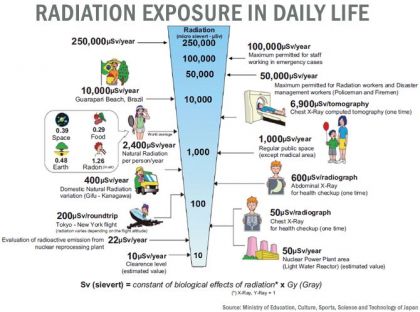
Besides natural sources of background radiation, there are also many artificial sources that we are exposed to routinely. This includes various medical procedures, but also smoking, since cigarette smoke contains a significant amount of radioactive polonium-210 that can cause cancer. Another radioactive activity is plane travel since at high altitudes we are more exposed to cosmic radiation that is usually shielded by the atmosphere. We list the most common artificial sources below. As you can see smoking is one of the most radioactive activities that a human can experience and by smoking one pack a day, in one year you will receive a dose 10 000 times larger than during an excursion to the Zone.
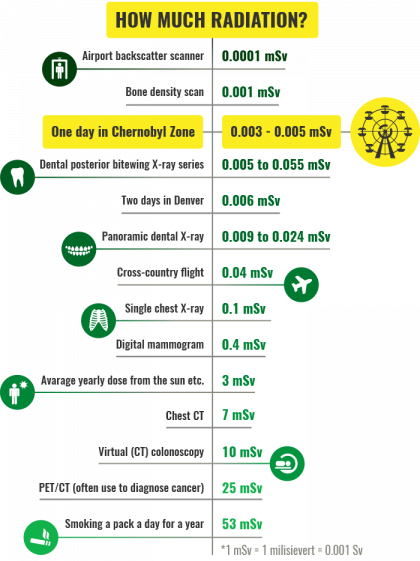
Four types of ionizing radiation
Alpha radiation
is the most common radiation since most of the radioactive isotopes decay by emitting alpha particles. The alpha particle consists of two protons and two neutrons. Since they are quite large and carry the electric charge, it is very easy to stop them. A piece of paper or a few centimetres of air is typically sufficient to effectively shield alpha radiation. However, if some alpha radioactive material is ingested or inhaled and comes into direct contact with the tissue of internal organs, it can cause damage and lead to adverse health problems. This is why it is necessary to avoid contamination of food, which is the main reason why it is strictly forbidden to consume any food during your trip in the Exclusion Zone.
Beta radiation
consists of electrons or so-called positrons. A piece of plastic, aluminium foil or a few meters of air can stop it relatively easily. Because of this your dosimeters will detect beta radiation only briefly in the vicinity of the so-called hot spots and hence does not pose a serious health risk. Similarly, as with alpha radiation, it is most important to avoid consumption of possible contaminated food. In Chernobyl, some hotspots might have beta particles, thus we avoid them.
Gamma radiation
is a type of electromagnetic radiation, the same as visible light or radio waves, but much more energetic. It is a very penetrating type of radiation that is best shielded by large amounts of lead or concrete. Gamma radiation is a very common type of radiation found everywhere around us and hence our bodies are accustomed to its low levels. Therefore, small quantities of gamma radiation do not pose serious health risk. This is the radiation you will measure in Chernobyl in small doses.

Neutron radiation:
is produced typically within nuclear fission that plays the crucial role in nuclear energy. It is a very penetrating type of radiation, which is best shielded by materials with high neutron content like paraffin or large quantities of water. However, it is a very rare type of radiation that can be found only in the vicinity of active nuclear reactors.
Looking for more radiation in your life? Bananas are the most radioactive fruit out there. They contain a radioactive isotope Potassium-40. Eating one banana is equal to a 0.1 microSieverts dose of radiation, however the instance of this radiation received by your body cannot be compared to smoking nor to visiting Chernobyl.
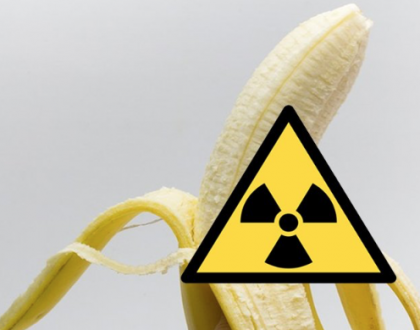
There are other places in the world that are naturally or historically radioactive; towards which people are not so prejudiced as they are towards Chernobyl.

Above all, we make sure that your Chernobyl excursion will be one of the safest adventures of your life.



 ChernobylX
ChernobylX
 ChernobylX
ChernobylX 